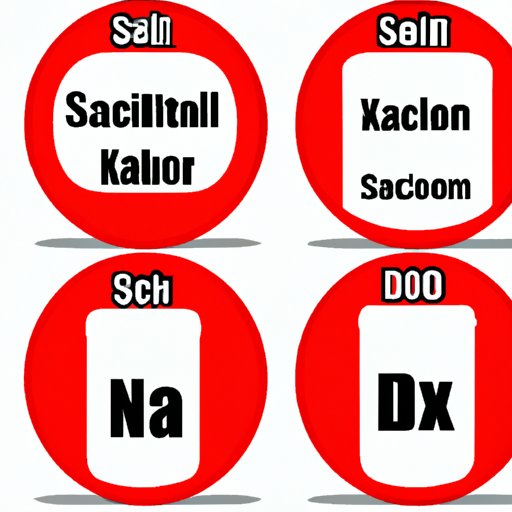
Introduction
In today’s society, where convenience foods and fast food culture are the norm, it is easy to unknowingly consume more sodium than what your body actually needs. According to the World Health Organization (WHO), sodium is an essential nutrient required for bodily functions such as maintaining fluid balance, transmitting nerve impulses, and controlling muscle contractions. However, as much as it is required for good health, consuming too much sodium can have adverse health effects, including high blood pressure and increased risk of heart disease.
The purpose of this article is to provide an in-depth understanding of sodium’s effects on human health and the importance of reducing its intake. The article covers the recommended daily intake of sodium, common sources of sodium in our diet, how to read food labels and monitor sodium intake, and the impact of high-sodium diets on different demographic groups. Finally, the article explores government policies and initiatives to reduce sodium intake, and concludes with a call to action to promote better health.
Understanding Sodium: How Much is Needed and How it Affects Health
Sodium is an essential mineral required for the proper functioning of the human body. It helps regulate body fluids, maintain blood volume, and transmit nerve impulses. However, the body requires only a small amount of sodium to function correctly. The average recommended daily intake of sodium is 2,300 milligrams (mg), or approximately one teaspoon of salt.
Consuming too much sodium can lead to negative health effects, including high blood pressure, increased risk of heart disease, stroke, and kidney disease. Consuming high levels of sodium causes the body to retain fluid, which, in turn, puts extra strain on the heart and blood vessels.
Common Sources of Sodium in Our Diet
One of the primary sources of sodium in our diets is processed and packaged foods, which are typically high in added salt to enhance their flavor and improve their shelf life. Some of the common sources of sodium in our diet include canned soups and vegetables, sauces, potato chips, and pickled foods.
Additionally, certain condiments, such as ketchup, soy sauce, and salad dressings, are also high in sodium. Table salt and baking soda are also significant sources of sodium in the diet.
In recent years, high-sodium diets have become more prevalent, which is a cause for concern given the negative health effects associated with consuming too much sodium. The risks associated with high-sodium diets are particularly significant for people with pre-existing health conditions, such as high blood pressure and kidney disease.
Understanding Food Labels and Monitoring Sodium Intake
Understanding food labels is an essential aspect of monitoring sodium intake. As mentioned earlier, processed and packaged foods are typically high in sodium. Reading food labels can help identify the sodium levels in these foods, making it easier to monitor intake and make informed dietary choices.
Monitoring sodium intake doesn’t necessarily mean giving up your favorite foods. You can reduce your sodium intake by using fresh ingredients and cooking from scratch at home. Additionally, using herbs, spices, and citrus juices to enhance flavor instead of adding salt can reduce sodium levels in your meals.
Choosing low-sodium options whenever possible can also help reduce sodium intake. When eating out, avoid ordering dishes with added salt or high-sodium condiments, and instead opt for fresh, low-sodium options.
Demographic Groups and the Impact of High-Sodium Diets
The impact of high-sodium diets varies by demographic group, with some groups being more susceptible to the negative health effects of consuming too much sodium. For example, people over 50 years old are more at risk of developing high blood pressure and other health conditions associated with a high-sodium diet.
The key to reducing the amount of sodium in our diets is to understand the specific dietary requirements of different demographic groups. For example, older adults may require less sodium than younger adults. Dietary recommendations for people with pre-existing conditions such as hypertension and kidney disease may also differ from those without any pre-existing conditions.
Studies that Support a Low-Sodium Diet
Citing studies from the New England Journal of Medicine, the American Heart Association, and other sources provide evidence for the benefits of a low-sodium diet. These studies demonstrate that reducing sodium intake can help lower blood pressure, reduce the risk of heart disease, and prevent strokes and kidney disease.
There is also growing pressure on food companies to reduce the sodium content of their products. This trend is particularly evident in the United States, where the Center for Science in the Public Interest filed a lawsuit against food companies for their excessive use of salt in their products. In response, some food manufacturers have started to reduce the sodium content of their products.
Government Policies and Efforts to Reduce Sodium Intake
The government can play a crucial role in promoting reduced sodium intake. In the United States, for example, the Food and Drug Administration (FDA) has issued new guidelines that encourage food companies to lower the sodium content in their products. Similarly, the WHO has released a set of guidelines aimed at reducing sodium intake worldwide.
Other initiatives include public education campaigns aimed at raising awareness of the impact of high-sodium diets and providing practical tips for reducing sodium intake. Public health campaigns such as these have been shown to be effective in promoting healthier dietary choices.
Conclusion
In conclusion, excessive sodium intake can have adverse health effects, including high blood pressure, stroke, and kidney disease. This article has highlighted the importance of reducing sodium intake by understanding the common sources of sodium in our diets, reading food labels, and making informed dietary choices.
While there is growing awareness of the impact of high-sodium diets on our health, there is still much work to be done to reduce sodium intake. Governments, food manufacturers, and public health officials all have a role to play in promoting healthier diets. By taking steps to monitor sodium intake and make healthier dietary choices, individuals can play their part in promoting better health.





